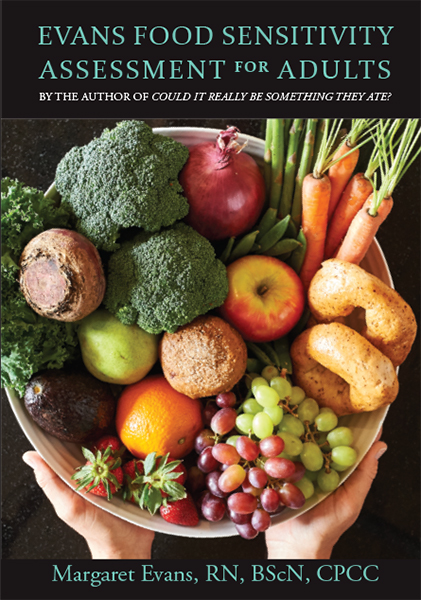Food Sensitivity Testing – What really works?
Food sensitivity testing is a controversial topic with a wide range of points of view. How can we possibly figure out what to do when the advice we are given by various health care professionals is so contradictory?
I have empathy for people in this situation, as I was once the mother of three young children with various symptoms that the medical community minimized and said were “normal”. That was 35 years ago and I have learned a great deal since then. It turned out that our children and myself had food intolerances and when the offending foods were removed, everyone’s health improved dramatically.
Food intolerances are different than food allergies. They are the result of compromised digestive health that usually begins in infancy or early childhood. Food allergies are related to the release of histamine in the body as a result IgE antibodies. Allergies can be accurately identified by a number of blood and skin tests but there is no accurate blood or skin test for food intolerances.
Currently, the most common test that is done for food intolerances is the IgG blood test. It is controversial and used primarily by naturopathic and pharmaceutical practitioners. The traditional medical community criticizes its validity and prefers to use the elimination diet method where many foods are eliminated and then gradually added back. So, how do you figure out what to do?
Here are my thoughts on the testing for both food allergies and food intolerances after working in the area for over 30 years and doing my best to keep up to date on the current research:
1.Most food reactions in adults and children are the result of food intolerances and not food allergies. Subjecting yourself or your child to scratch or blood tests that are looking for an IgE response to food is unlikely to give you the answers you need. IgE testing is accurate and worthwhile if your child has symptoms that suggest the release of histamine such as hives, chronic runny nose, seasonal pollen symptoms, or an anaphylactic reactions to any food or other substance. If scratch type tests are done on a child, only a very few should be done and the ones tested should be based on a comprehensive history of the child’s symptoms.
2.Elimination diets most often produce inaccurate and inconclusive results because of the difficulty of patient compliance. People are given the diet but little or no information on how to do it, where to purchase the unusual ingredients, or how to create meals that their family or themselves will actually want to eat.
3.IgG testing, which is currently most often used to test for food intolerances has no studies that are reproducible to determine their accuracy. People and companies that have a vested interest in the topic conduct all the research and there are few studies done by impartial professionals. Current science shows that the more a food is consumed, the higher the level of IgG. It has also been demonstrated that as food tolerance improves, the level of IgG often goes up. In the end, I believe that the accuracy of this test is uncertain enough that I would not use it as the sole way to identify the foods causing symptoms in a patient.
4.Both IgG testing and the elimination diet remove many foods from the diet and this is not practical in the life of real people. I see clients all the time that have attempted to follow the recommendations from a professional for one of these protocols but gave up very early on. They often never return to the person prescribing the test or return and give false information. I hear these stories in my practice all the time. Unfortunately, people then throw out the entire idea that food is the cause of their symptoms and never find the answers they were looking for.
5.Both IgG and the elimination diets do not identify the major offender that is the underlying trigger for the person’s symptoms. There is, I believe, always a main trigger food that has been consumed by the person regularly over a span of years and is usually a problem for other members of the patient’s immediate and extended family. If this trigger is not removed, the removal of many other foods will not offer the patient any significant amount of improvement.
6.Both the IgG and the elimination diet often result in the client removing many of the recommended foods and working hard at adjusting the diet. They do not, however, remove the food that is eaten often and that they crave as they usually find this too difficult. I hear from parents often, “I removed 18 of the 20 foods from his diet but I could not remove the other 2 or he would starve.” Truthfully, the offender is the one that the child eats all the time and is an ingredient in the foods he craves.
7.Both the IgG and elimination diet process can result is a decrease in the nutrition status of the patient. When many foods are eliminated, it becomes more and more difficult to ensure that the patient is eating a balanced diet. Because people with digestive symptoms already have difficulty with the absorption of nutrients, it is unwise to encourage patients to remove multiple foods from their diet. This is particularly important in children.
8.IgG testing is expensive and usually costs about $500 plus consultation appointments both before and after the test. Because of this, many people give up even trying to see a naturopath to figure out if food is a problem, as they know the costs will be more than they can afford.
Because I have lived the story of food sensitivities myself, with my family, and with hundreds of clients, I have developed another way. My new Evans Food Sensitivity Assessment Tool (EFSAT) will help you figure out if food is at the root of your own or your child’s symptoms and will help you accurately determine what the trigger is. I have used this process in my private practice for many years and have achieved consistently positive results. Clients get better and they do it in a way that is simple, manageable in their real life, cost effective, and that does not compromise their nutrition.
Below are a few references on the different points of view:
https://sciencebasedmedicine.org/igg-food-intolerance-tests-what-does-the-science-say/
https://aacijournal.biomedcentral.com/articles/10.1186/1710-1492-8-12
https://www.allergy-clinic.co.uk/allergies/introduction-to-allergy/controversial-tests/




